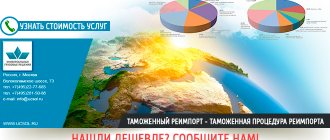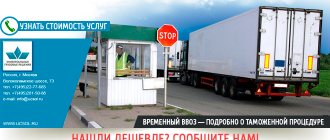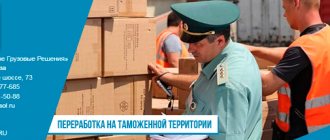HomeCustoms clearanceCustoms procedures Re-export
Re-export is a customs procedure (formerly a customs regime) established by the EAEU Labor Code in force since January 1, 2018, in which foreign goods previously imported into the territory of the EAEU countries are exported without paying customs and other duties, taxes or their return (offset).
The re-export customs procedure code is EK31 , which is indicated when filling out column 1 of the customs declaration by a legal entity or individual entrepreneur.
Column 1 consists of three cells and is filled out as follows:
|
More details about filling
Contents of the re-export procedure and in what cases it is required
A prerequisite for applying for the customs procedure for re-export of foreign (previously imported) goods is to conduct customs inspection when importing goods into the customs territory of the EAEU, and in case of return to the supplier, repeat customs inspection for export. Nowadays, this customs procedure “re-export” is very complex and is practically not used, and the return of goods is carried out through the procedure - export.
The re-export procedure is needed:
- To complete customs procedures: Temporary import;
- Processing in customs territory;
- Processing for domestic consumption;
- Bonded warehouse;
- Free customs zone;
- Release for internal consumption.
Examples of re-export
Example 1: they were unable to obtain permits for the import of goods (the import permit was not received; the products have not been certified or do not meet phytosanitary standards). Result: I had to take the goods back to the supplier.
Example 2: the supplier imported a consignment of goods that was found to be defective; the re-export procedure was used to return the defective goods. Result: return of goods to the supplier.
Example 3: the supplier imported goods that do not meet the customer’s requirements (wrong size, wrong color, wrong style); in order to return the goods, the goods were placed under the re-export procedure. Result: return export of goods.
Documenting
Re-export can be carried out only if you have a complete package of documents, subject to compliance with all requirements and standards.
Documents for re-export
- Application from the importer.
- A document explaining the reasons for import and return conditions.
- Complaint to the supplier and his consent to return and replace the goods.
- Checks and receipts for all necessary contributions (if the goods enter the territory of the Russian Federation).
- Documents (import/export contracts) confirming the status of re-export goods.
- Invoices of the parties.
- Declaration.
- Certificate of acceptance of goods of foreign origin.
The possibility of replacing one procedure with another cannot be ruled out.
By outsourcing foreign trade support, you will free yourself from solving complex problems. Only professionals will be able to correctly prepare customs documents and ensure safety when escorting goods to a warehouse or destination.
Types of re-export
The reasons why a product is placed under this procedure may vary. In addition to forced, deliberate re-export can be used. For example, in the case of warranty repairs, the goods are imported into the territory of the EAEU, where they are repaired; after repairs, the goods are returned to the country for further use.
According to customs legislation, re-export is allowed: cars, samples of goods, oil, petroleum products, gas, and other goods.
There are 2 types of re-export:
- Direct re-export – goods are imported into the supplier’s country.
- Indirect re-export - goods purchased abroad are immediately sent for resale to a third country.
Refund, refund or deduction of VAT on export
All three terms meaning reduction or exemption from tax payments are often found on the Internet, and they are easy to confuse:
- the deduction refers to the calculation of the amount of tax (Article 171), determined by the enterprise itself when filing a declaration;
- refund or return of VAT when exporting from Russia is a general concept for offset and return (Article 176), the issue is decided by the Federal Tax Service on the basis of submitted documents: declarations and applications.
Paying taxes often leads to a situation where, due to deductions, the tax amount becomes negative. Further steps for tax refund:
- The company submits a declaration and an application for credit or refund of VAT. Offset on the declaration - the amount goes towards fines, arrears or future payments; If the documents indicate a return, the amount is transferred to a bank account.
- The tax office checks information in reporting declarations within three months, as provided for in Article 88 of the Tax Code of the Russian Federation on a 0 percent VAT rate for exports. Tax authorities are authorized to request additional documents, such as copies of invoices, sales ledgers or clarifying declarations.
- She then makes a decision within seven days about full, partial, or refusal of reimbursement. The form of compensation - offset or refund - is determined either by the Federal Tax Service to cover arrears to the budget, or according to the application.
- The Federal Inspectorate sends payment documents to the Treasury the next day after the decision on the return is made. The money is transferred by the Treasury within five days.
Customs payments for re-export
Features of customs payments when re-exporting (exporting) previously imported goods into the EAEU:
- A customs duty of 750 rubles is paid;
- No export customs duty is paid;
- And duties that were paid when importing goods can be returned back to the sender.
Forced re-export - when the entrepreneur did not assume in advance that he would export the goods back, paid import customs payments: fees, duties, VAT, excise, but discovered a defect in the imported goods. Return of goods upon complaint to the supplier according to the re-export procedure is possible subject to certain conditions. Availability of customs inspection upon import and reverse inspection upon export! In this case, customs duties paid upon import can be returned to the payer (duty, VAT, excise tax), with the exception of customs duties! Also, when re-exporting, a customs clearance fee of 750 rubles is paid again.
Intentional re-export - when it is known in advance that the goods will be returned back. For example, a product requires warranty repairs, which will be carried out by the supplier free of charge (within the prescribed warranty conditions and repairs specified in the supply contract) after which it will be returned back to the owner (buyer). In this case, the re-export procedure with payment of a customs duty of 750 rubles is closed by the import procedure 40 (import for domestic consumption). In some cases, the processing procedure in the customs territory is applied.
What is re-export of goods?
Re-export of goods is a customs procedure in which those goods that were previously imported into the Customs Union can be exported from there without appropriate duties. And in cases where customs duties have already been paid, re-export involves monetary compensation for them. In addition, non-tariff regulation procedures are not applied to products subject to re-export and taxes are not paid. These rules are established by Articles 202 and 296 of the Customs Code of the Customs Union.
In other words, summarizing the above, we can simplify the definition to the following formulation: re-export is the redirection abroad of goods previously imported into the customs territory of the state. In addition to the already mentioned information that customs duties are not applied to goods subject to re-export (or funds already paid are returned), it is also worth mentioning that they are not subject to the restrictions that are established in the country regarding foreign trade activities.
Until recently, only the import and export of goods was in demand in the Russian Federation. Re-export of goods is a relatively new procedure for domestic customs practice. They first thought about it at the end of the summer of 2012 (August 22), since those economic conditions made it necessary to have a customs regime for the re-export of goods. Many trade organizations and enterprises understood the advantages of this approach to economic relations, so the re-export of goods became a natural step in the development of the domestic market. Thanks to innovations, it was possible not only to significantly increase the economic status of the Russian Federation, but also to significantly expand its market opportunities.
When placing goods under the customs regime for re-export, you should always be guided by Article 297 of the Customs Code of the Customs Union, which establishes the categories of goods that may be subject to this procedure:
- Foreign goods located in the customs territory of the Customs Union, including those imported in violation of non-tariff regulation criteria;
- Goods under the customs release procedure, intended for domestic consumption, but subject to the condition that they are returned due to non-compliance with any characteristics (shape, color, volume, quality, etc.).
But this does not mean that re-export of such goods can always be carried out. This procedure has a number of restrictions that must be taken into account, namely it is prohibited:
- Re-export goods if they have stayed in the country for more than a year.
- Re-export goods if they do not have all the necessary documentation provided in Article 299 of the Customs Code of the Customs Union.
- Re-export goods if repairs of goods subject to re-export were carried out on the territory of the customs union, or they were used there. But sometimes there are exceptions - in cases where, for example, in order to identify a defect, it is necessary to use the product for its intended purpose, in other words, to evaluate its quality experimentally.
- Re-export goods if the customs authority is unable to identify them.
According to established customs norms and rules, in cases where re-export of Russian goods for one reason or another is impossible, their export is allowed (that is, they are exported abroad under general conditions, including the payment of duties and taxes).
As a rule, it is customary to distinguish two types of re-export of goods:
- Direct re-export is a procedure in which the re-exported goods must be delivered to the resident country;
- Indirect re-export is a procedure in which re-exported goods can be immediately sent to any other territory, bypassing the resident country.
Read the article: Non-resource exports using the example of Russia
Features of re-export in 2021
Features of re-export are regulated by the EAEU Labor Code. In Russia, all participants in foreign trade activities immediately appreciated its advantages. What is the difference between export and re-export?
When exporting, you will have to pay all customs duties, but it is easier to prepare customs documents.
When re-exporting, you do not need to pay customs duties, but you must collect all the necessary documents and obtain permission from the customs authority. In 2021, re-export of goods to the Russian Federation is no different from the previous year.
Conditions for re-export of goods:
- No more than 1 year has passed since the date of release of the product;
- All necessary documents are present;
- The customs declaration must contain the article numbers or serial numbers present on the goods.
VAT when exporting goods from Russia
The peculiarities of the value added tax when exporting products are discussed in clause 2 of Art. 151, paragraph 1, art. 164, paragraph 1, art. 165, paragraph 9 of Art. 167 of the Tax Code of Russia. Exported goods and materials are not sold to Russian consumers, so the state returns the tax previously paid by the manufacturer. The terms “no tax paid” and “0% rate” are used synonymously. All primary documents confirming the export of goods that should be submitted to the tax office are specified in the agreement on the Eurasian Economic Union dated May 29, 2014 (Appendix No. 18) and in Article 165 of the Tax Code of the Russian Federation. Taxpayers and agents provide supporting documents in electronic format; the validity of the provisions is enshrined in the order of the Federal Tax Service dated September 30, 2015 No. ММВ-7-15/427.
Registration of customs procedures for re-export of cargo and goods
Ours is a customs broker (representative) and deals with the registration of re-export of any cargo and goods at any customs offices of the Russian Federation:
- At airports
- In seaports
- At railway stations
- At cargo automobile terminals – temporary storage warehouse
- Express postal items
If necessary, we carry out customs clearance of goods in any other customs procedures!
We work with any participants in foreign trade activities:
- Legal entities
- Individual entrepreneurs
Documents and information for registration of goods and cargo under the re-export procedure (EC 31)
- List of documents for registration of a Legal entity at customs (View)
- List of documents for registration of an individual entrepreneur at customs (View)
- List of documents for completing the “Re-export” procedure (View)
Right to refuse
From 2021, 0% value added tax on exports has become not an obligation, but a right of payers. They were given the opportunity not to officially apply the exemption to exported goods. Refusal is possible for all export transactions as a whole, provided that an application is submitted to the tax service no later than the 1st day of the quarter from which the taxpayer plans to pay VAT according to the usual rules.
IMPORTANT!
You cannot refuse the zero rate when exporting to the EAEU. The provisions of the Treaty on the EAEU regarding the justification of clause 3 of the protocol do not provide for such an opportunity for taxpayers (clause 1 of Article 7 of the Tax Code of the Russian Federation).
The total period of refusal is no less than a year. Payers need this if they want to accept tax deductible at rates of 20% or 10% from suppliers who, having the right to a zero rate, do not want to confirm it, highlighting the regular tax in their invoices. To apply this benefit, the company will have to collect documents to confirm the 0 rate for export and submit them to the Federal Tax Service.
In past periods, tax authorities paid close attention to those who regularly “forget” to collect the necessary documents. Organizations were cunning, tried to buy VAT documents, carried out some export operations at the usual rate of 10% or 20% (18% until 2021), but processed something at 0%. Now there is no need to resort to such difficulties.
Terms and cost of re-export registration
The re-export procedure takes 1 day!
At the same time, the price or cost of customs clearance services under the procedure of re-export of goods in our company is the minimum in the market and depends on the place of customs clearance and the tasks set by the foreign trade participant, on average it can be:
- Individual – 3000-15000 rubles.
- Legal entity or individual entrepreneur - 5,000-15,000 rubles.
We are confident that we will make you the best offer!
Tax accounting and VAT reporting for export
In tax accounting, operations for the export of goods are recorded separately from the rest, using special registers. Organizations are required to maintain separate VAT accounting for exports and domestic sales of goods, works and services. It consists of using subaccounts and separate statements and journals. Sections 4-6 are completed in the tax return:
- if the zero rate is confirmed, then sheet 4 of the declaration is drawn up;
- if not confirmed - sheet 6 of the declaration;
- sheet 5 is rarely used.
The declaration form identifies more types of export transactions than the Tax Code of the Russian Federation - an individual accounting register is provided for each of them.
ConsultantPlus experts analyzed in detail the specifics of taxation during exports: how to calculate VAT, what rates to use, how to maintain separate accounting. Use these instructions for free.
Paying tax
Payment of taxes and duties at customs today can be made in various ways: using ATMs, electronic or payment terminals, etc. Depending on the chosen method of paying customs VAT, as confirmation of this fact, the importer can provide the controllers with the relevant documents - receipts or payment orders .
If the taxpayer complies with all the conditions considered, customs VAT can be deducted.
To learn about which persons become payers of customs VAT, read the material “Who is a VAT payer?”
Further use of the product
The condition on the possibility of refunding import VAT solely for the subsequent use of goods in transactions subject to this tax does not require any special confirmation from the importer for him to make tax deductions.
However, keep in mind: if this condition was not met (and controllers will certainly identify this in the future), the use of such deductions will be regarded as unlawful, with all the ensuing consequences. The same applies to non-compliance with the condition regarding the use of imported goods only within the country.
Registration
As for the acceptance of goods for registration, the Tax Code of the Russian Federation still does not contain unambiguous interpretations explaining what documents the importer can use to confirm this fact to the inspectors. However, the general legal practice in this case is such that there will be no confirmation of acceptance of the goods for registration if the taxpayer does not have a primary document drawn up in accordance with the norms of the current legislation.
About the documents that serve as the basis for the capitalization of incoming inventory items, read the article “Maintaining document flow for warehouse accounting of materials.”
Step-by-step instructions for confirming the zero VAT rate for export
When exporting to Belarus, Kazakhstan, Armenia, zero VAT is confirmed:
- An agreement under which a buyer from an EAEU country imports products.
- Application for import of goods and payment of indirect taxes from the buyer.
- Transport or shipping documents (consignment note TTN is recommended).
How to confirm the 0 VAT rate when exporting to other countries - send to the Federal Tax Service:
- An agreement or other documents related to the transaction, if there is no agreement (for example, an offer and acceptance).
- A copy of the customs declaration or an electronic register (a separate register is provided for each type of transaction).
- Copies of transport or shipping documents with customs marks or their electronic register.
Other documents (bank statements, invoices) do not have to be attached to the declaration, but should be kept in case the tax office asks to confirm the information specified in the declaration.
If the taxpayer has not provided documents confirming the zero tax rate, then VAT must be calculated according to general principles, and all calculations must be disclosed in the declaration. For example, at a rate of 10% or 20%.










